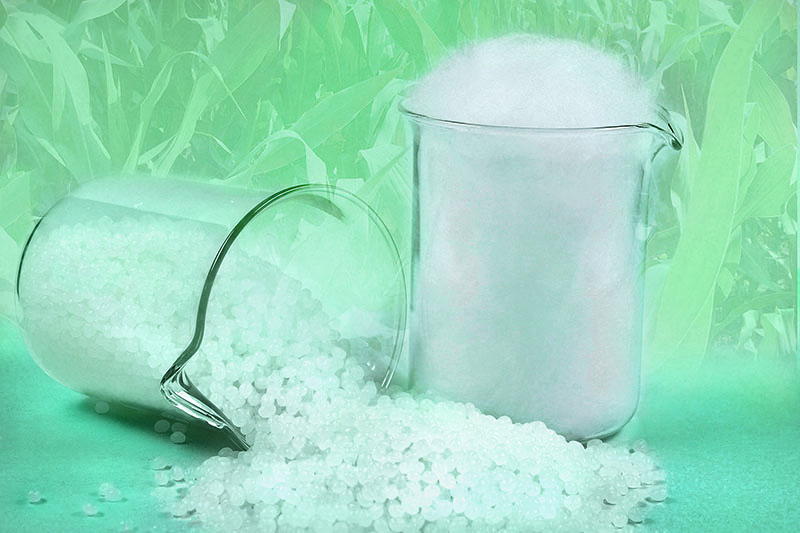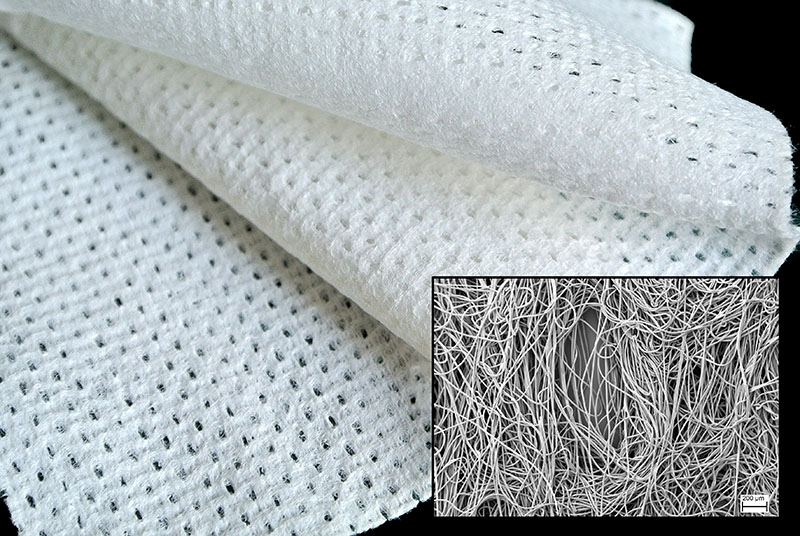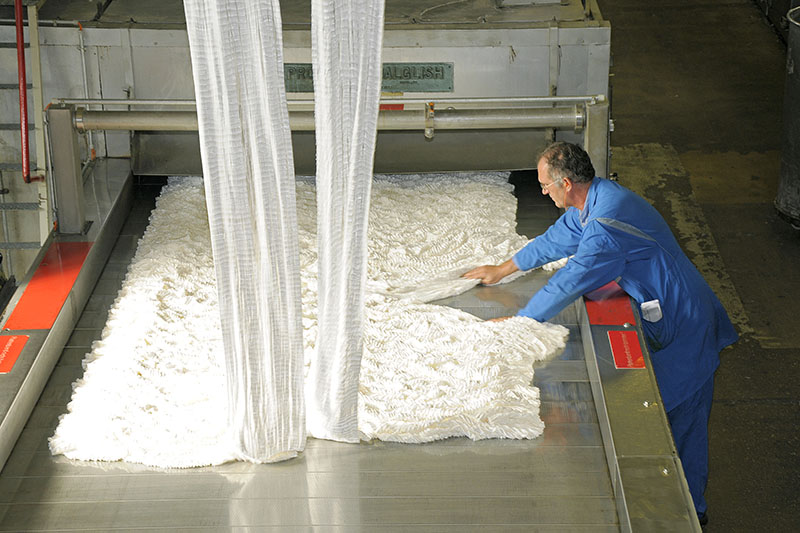Polyester staple fiber production at Trevira in Bobingen/Bavaria (Germany).
Modern manmade fiber products must cater to the growing need of the industry for custom-made products. The materials needed in all applications of the textiles- and nonwoven- industries often require the raw materials employed to possess inherent – and possibly multiple – functions.
New products and diminished or polluted resources require new materials. Global megatrends result in rising demands in terms of quality, hygiene standards and new consumer goods. A constant further specialization in industrial and technical applications is now taking place, and along with the enhanced functionality, the range of applications for manmade fibers has also broadened.
This trend is not limited to traditional textile products like apparel, home textiles or automotive interiors. On the contrary, technological progress has resulted in a demand for fibers for technical end uses, and one which has been particularly rising. New energy sources and electro mobility, for example, require powerful storage devices. Manmade specialty fibers constitute the perfect material for battery separators, and they are also the material of choice for filtration and insulation, hygiene materials, food packaging, wallpaper and other consumer products, as well as for composites for technical applications. A strong focus will be on disposable (and also flushable) hygiene products, and on air and water treatment. In order to provide sufficient drinking water for a growing population, there is a need for state-of-the-art filter technologies – these are applications for modern polyester fibers. There are many other possible new applications for which polyester, the manmade fiber polymer group most widely used, offers an extensive variety of products.
A further important aspect in the fiber market is the demand for “greener products” – be it by way of sustainable manufacturing and new technologies for conventional raw materials or by employing ecological alternatives like biopolymers. As far as conventional raw materials are concerned, manmade fibers like polyester have some advantages over natural fibers here, since they consume less land and water in their manufacture, and their functions can be incorporated in the raw material, without the need of later chemical or mechanical surface treatment. Fiber raw materials made from renewable resources can also have the advantage that they are biodegradable.
European fiber suppliers with their decades of experience have shifted their focus from simple low-price commodity fibers and yarns to sophisticated new niche products and high-end customized developments. Advantages of the European manufacturers are their flexibility and ability to provide small quantities and customized specialties. Fiber manufacturers like Trevira with its 60 years of know-how in polyester making and long-standing close customer relationships, act as partners for their customers in exploring and developing new specialties for new applications.

Materials of the future: new fiber developments
The latest developments in Trevira Fibers for nonwovens and technical applications include products for all technologies: carding (blend of different long-cut fibers by thermal or chemical bonding, needle punch or hydroentanglement/spunlace); airlaid (blend of wood pulp with crimped 3 –12 mm short-cut fibers by thermal or chemical bonding); and wetlaid (for example wood pulp in blends with uncrimped short-cut fibers). Market demands concern product safety (especially in hygiene applications), good processability (high throughput and good technical performance) and functionality in terms of bonding behavior and haptic properties of the surface.
• Bi-component fibers, both in long- and short-cut versions are indispensable for strengthening nonwoven materials via thermal bonding. As they substitute for chemical bonders, they are also environmentally friendly. There are various polymer combinations available. These materials are used e.g., for energy storage systems, air filters, construction and insulation. Where required – for example in the automotive industry – inherently flame resistant fibers are also available.
• Biologically degradable fibers made from PLA/IngeoTM have formed part of the product portfolio since 2010. They provide an ecological alternative to conventional fibers and cover new applications and niche markets. As the demand in various market segments for special sustainable raw materials made from renewable resources is rising, Trevira is constantly extending its PLA product range. The latest developments include long staple fiber types for carding and short-cut fibers (crimped or uncrimped). Also new are bi-component PLA/PLA fibers for thermally bonded nonwovens and bi-component fibers based on PLA/PBS. These have the additional ecological advantage that their melting points are significantly lower than those of standard polyester bi-component fibers. Applications are, for example: food packaging, fiberfill or wipes, but also tailor-made product developments for special applications.
• Further developments are short-cut fibers in fine titers for filtration, amorph homopolymer fibers for applications where core/sheath fiber structures are not required, or oleophobic/hydrophobic fibers in combination with FR properties for insulation and filtration products.
The business with fibers for nonwovens and technical fibers aside, Trevira offers a wide range of other fiber and filament specialties. Latest multifunctional developments are apparel fibers, which combine low-pilling, antimicrobial and moisture control properties in one fiber; and for the home textile market the company has developed spun-dyed flame retardant hybrid yarns with a low-melt component, which allow permanent shaping and stiffening of fabrics suitable for sun-screening or sound-proofing.

Outlook
In general, one can say that industrial and technical applications will keep on evolving and the demand for customized fibers will continue to grow. The task of the fiber manufacturers is to keep pace with this development and support the progress with raw materials in new polymer modifications and combinations, which allow a further functionalization of the end product. The market needs new “intelligent” materials with added properties to save raw materials and resources. Manmade fibers can provide solutions, which cannot be achieved by natural fibers alone.
For more information contact:
Trevira GmbH, Marketing/Communications
Philipp-Reis-Str. 4
D-65795 Hattersheim
Germany
Tel: +49 8234-9688-2502
Fax: +49 8234-9688-5342
Email: trevira.press@trevira.com
Website: www.trevira.com


